Resourcing and Talent Planning Report: UK and US Trends
VerifiedAdded on 2021/02/19
|22
|6508
|458
Report
AI Summary
This report provides a comprehensive analysis of resourcing and talent planning, focusing on labor market trends in the UK and US, particularly in relation to the retail giant TESCO. It delves into the importance of tight and loose workforce markets, strategies for achieving competitive advantage, and the roles of government, trade unions, and employers in future skill development. The report examines workforce planning principles, tools, career development, downsizing, job descriptions, recruitment, and selection processes. Additionally, it explores employee retention strategies, lawful practices for managing dismissal, retirement, and redundancies. The report highlights the significance of HR analytics and strategic workforce planning for organizational success. It also covers the impact of globalization, economic changes, and technological advancements on the labor market, offering insights into TESCO's approach to talent management and workforce optimization.
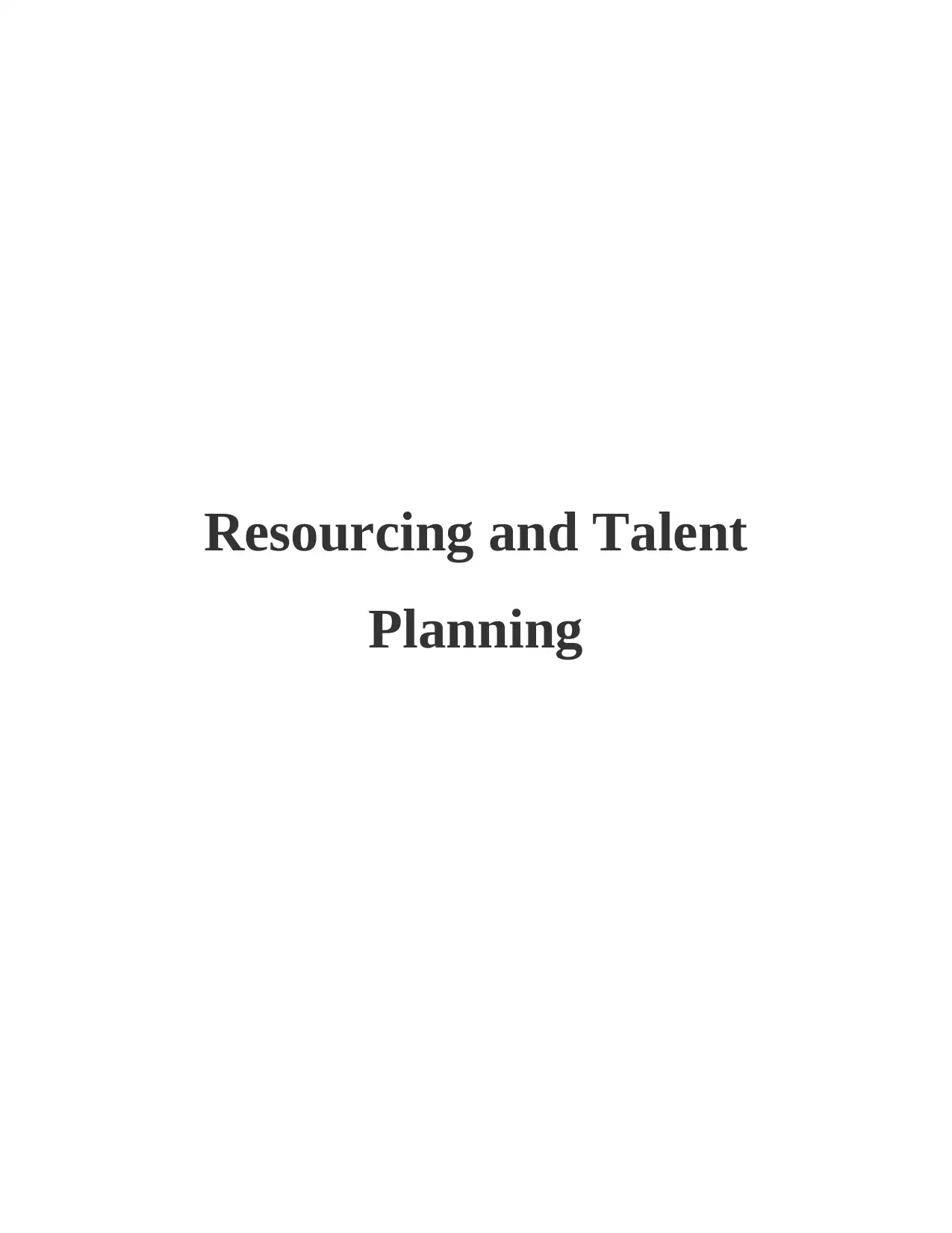
Resourcing and Talent
Planning
Planning
Paraphrase This Document
Need a fresh take? Get an instant paraphrase of this document with our AI Paraphraser
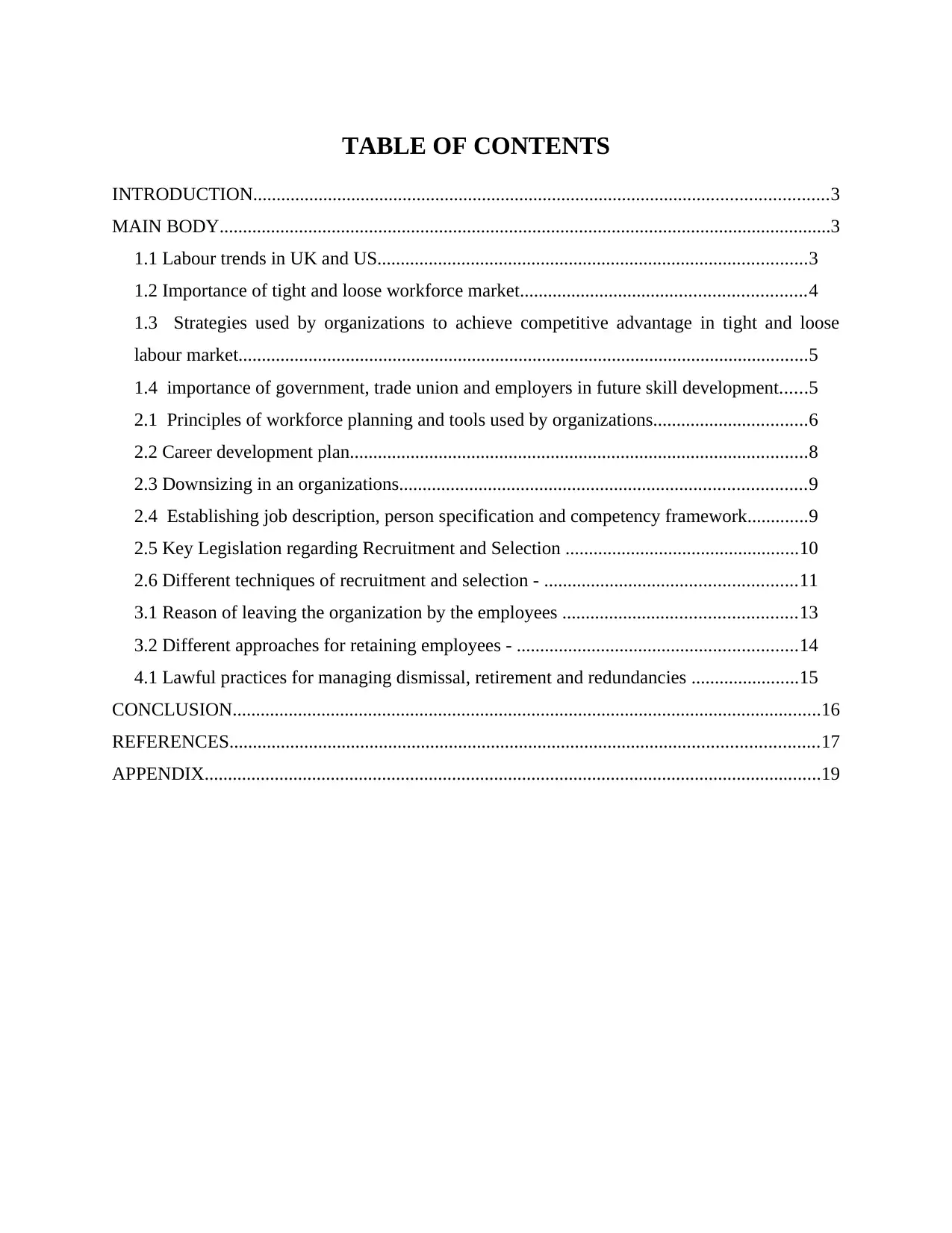
TABLE OF CONTENTS
INTRODUCTION...........................................................................................................................3
MAIN BODY...................................................................................................................................3
1.1 Labour trends in UK and US............................................................................................3
1.2 Importance of tight and loose workforce market.............................................................4
1.3 Strategies used by organizations to achieve competitive advantage in tight and loose
labour market..........................................................................................................................5
1.4 importance of government, trade union and employers in future skill development......5
2.1 Principles of workforce planning and tools used by organizations.................................6
2.2 Career development plan..................................................................................................8
2.3 Downsizing in an organizations.......................................................................................9
2.4 Establishing job description, person specification and competency framework.............9
2.5 Key Legislation regarding Recruitment and Selection ..................................................10
2.6 Different techniques of recruitment and selection - ......................................................11
3.1 Reason of leaving the organization by the employees ..................................................13
3.2 Different approaches for retaining employees - ............................................................14
4.1 Lawful practices for managing dismissal, retirement and redundancies .......................15
CONCLUSION..............................................................................................................................16
REFERENCES..............................................................................................................................17
APPENDIX....................................................................................................................................19
INTRODUCTION...........................................................................................................................3
MAIN BODY...................................................................................................................................3
1.1 Labour trends in UK and US............................................................................................3
1.2 Importance of tight and loose workforce market.............................................................4
1.3 Strategies used by organizations to achieve competitive advantage in tight and loose
labour market..........................................................................................................................5
1.4 importance of government, trade union and employers in future skill development......5
2.1 Principles of workforce planning and tools used by organizations.................................6
2.2 Career development plan..................................................................................................8
2.3 Downsizing in an organizations.......................................................................................9
2.4 Establishing job description, person specification and competency framework.............9
2.5 Key Legislation regarding Recruitment and Selection ..................................................10
2.6 Different techniques of recruitment and selection - ......................................................11
3.1 Reason of leaving the organization by the employees ..................................................13
3.2 Different approaches for retaining employees - ............................................................14
4.1 Lawful practices for managing dismissal, retirement and redundancies .......................15
CONCLUSION..............................................................................................................................16
REFERENCES..............................................................................................................................17
APPENDIX....................................................................................................................................19
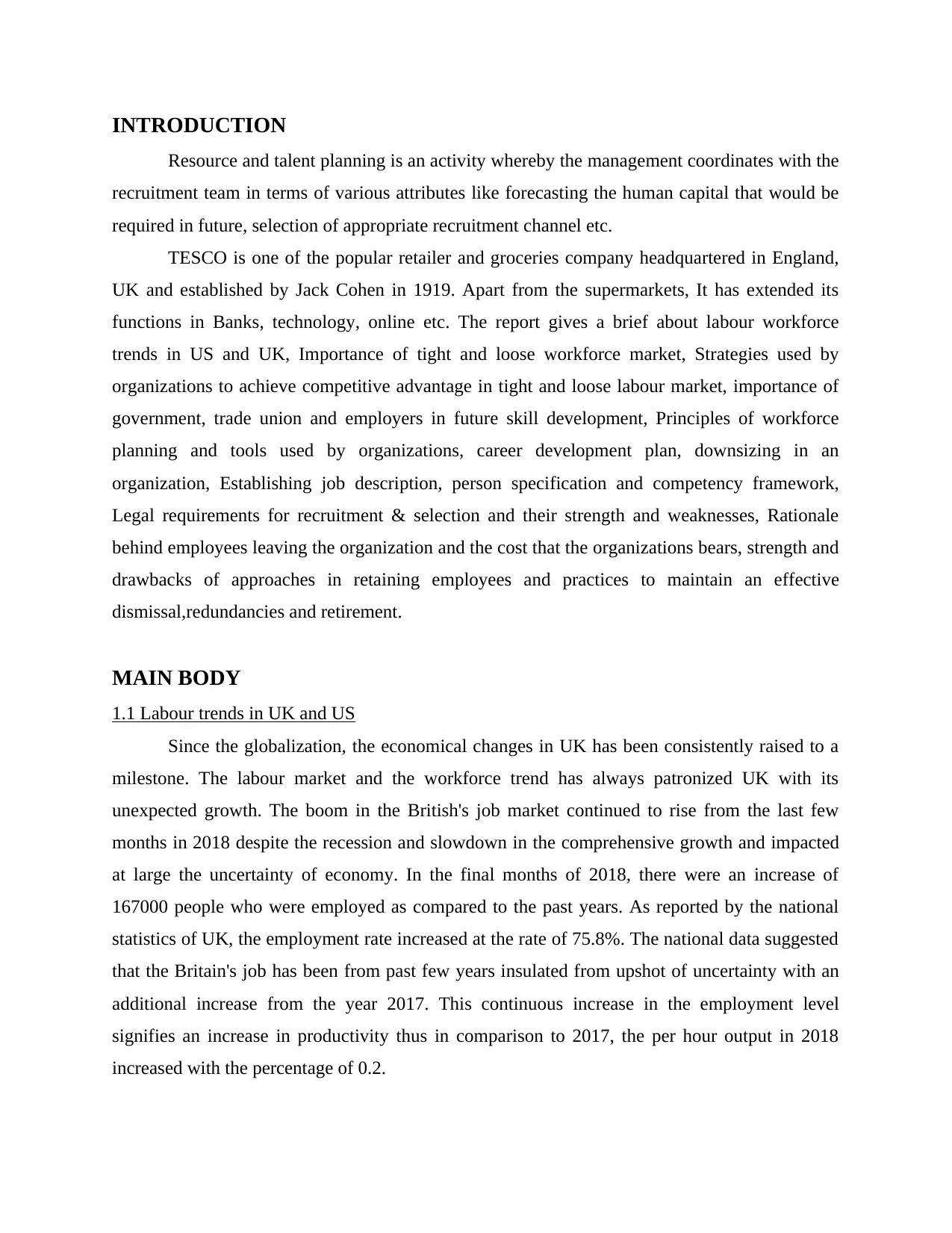
INTRODUCTION
Resource and talent planning is an activity whereby the management coordinates with the
recruitment team in terms of various attributes like forecasting the human capital that would be
required in future, selection of appropriate recruitment channel etc.
TESCO is one of the popular retailer and groceries company headquartered in England,
UK and established by Jack Cohen in 1919. Apart from the supermarkets, It has extended its
functions in Banks, technology, online etc. The report gives a brief about labour workforce
trends in US and UK, Importance of tight and loose workforce market, Strategies used by
organizations to achieve competitive advantage in tight and loose labour market, importance of
government, trade union and employers in future skill development, Principles of workforce
planning and tools used by organizations, career development plan, downsizing in an
organization, Establishing job description, person specification and competency framework,
Legal requirements for recruitment & selection and their strength and weaknesses, Rationale
behind employees leaving the organization and the cost that the organizations bears, strength and
drawbacks of approaches in retaining employees and practices to maintain an effective
dismissal,redundancies and retirement.
MAIN BODY
1.1 Labour trends in UK and US
Since the globalization, the economical changes in UK has been consistently raised to a
milestone. The labour market and the workforce trend has always patronized UK with its
unexpected growth. The boom in the British's job market continued to rise from the last few
months in 2018 despite the recession and slowdown in the comprehensive growth and impacted
at large the uncertainty of economy. In the final months of 2018, there were an increase of
167000 people who were employed as compared to the past years. As reported by the national
statistics of UK, the employment rate increased at the rate of 75.8%. The national data suggested
that the Britain's job has been from past few years insulated from upshot of uncertainty with an
additional increase from the year 2017. This continuous increase in the employment level
signifies an increase in productivity thus in comparison to 2017, the per hour output in 2018
increased with the percentage of 0.2.
Resource and talent planning is an activity whereby the management coordinates with the
recruitment team in terms of various attributes like forecasting the human capital that would be
required in future, selection of appropriate recruitment channel etc.
TESCO is one of the popular retailer and groceries company headquartered in England,
UK and established by Jack Cohen in 1919. Apart from the supermarkets, It has extended its
functions in Banks, technology, online etc. The report gives a brief about labour workforce
trends in US and UK, Importance of tight and loose workforce market, Strategies used by
organizations to achieve competitive advantage in tight and loose labour market, importance of
government, trade union and employers in future skill development, Principles of workforce
planning and tools used by organizations, career development plan, downsizing in an
organization, Establishing job description, person specification and competency framework,
Legal requirements for recruitment & selection and their strength and weaknesses, Rationale
behind employees leaving the organization and the cost that the organizations bears, strength and
drawbacks of approaches in retaining employees and practices to maintain an effective
dismissal,redundancies and retirement.
MAIN BODY
1.1 Labour trends in UK and US
Since the globalization, the economical changes in UK has been consistently raised to a
milestone. The labour market and the workforce trend has always patronized UK with its
unexpected growth. The boom in the British's job market continued to rise from the last few
months in 2018 despite the recession and slowdown in the comprehensive growth and impacted
at large the uncertainty of economy. In the final months of 2018, there were an increase of
167000 people who were employed as compared to the past years. As reported by the national
statistics of UK, the employment rate increased at the rate of 75.8%. The national data suggested
that the Britain's job has been from past few years insulated from upshot of uncertainty with an
additional increase from the year 2017. This continuous increase in the employment level
signifies an increase in productivity thus in comparison to 2017, the per hour output in 2018
increased with the percentage of 0.2.
⊘ This is a preview!⊘
Do you want full access?
Subscribe today to unlock all pages.

Trusted by 1+ million students worldwide
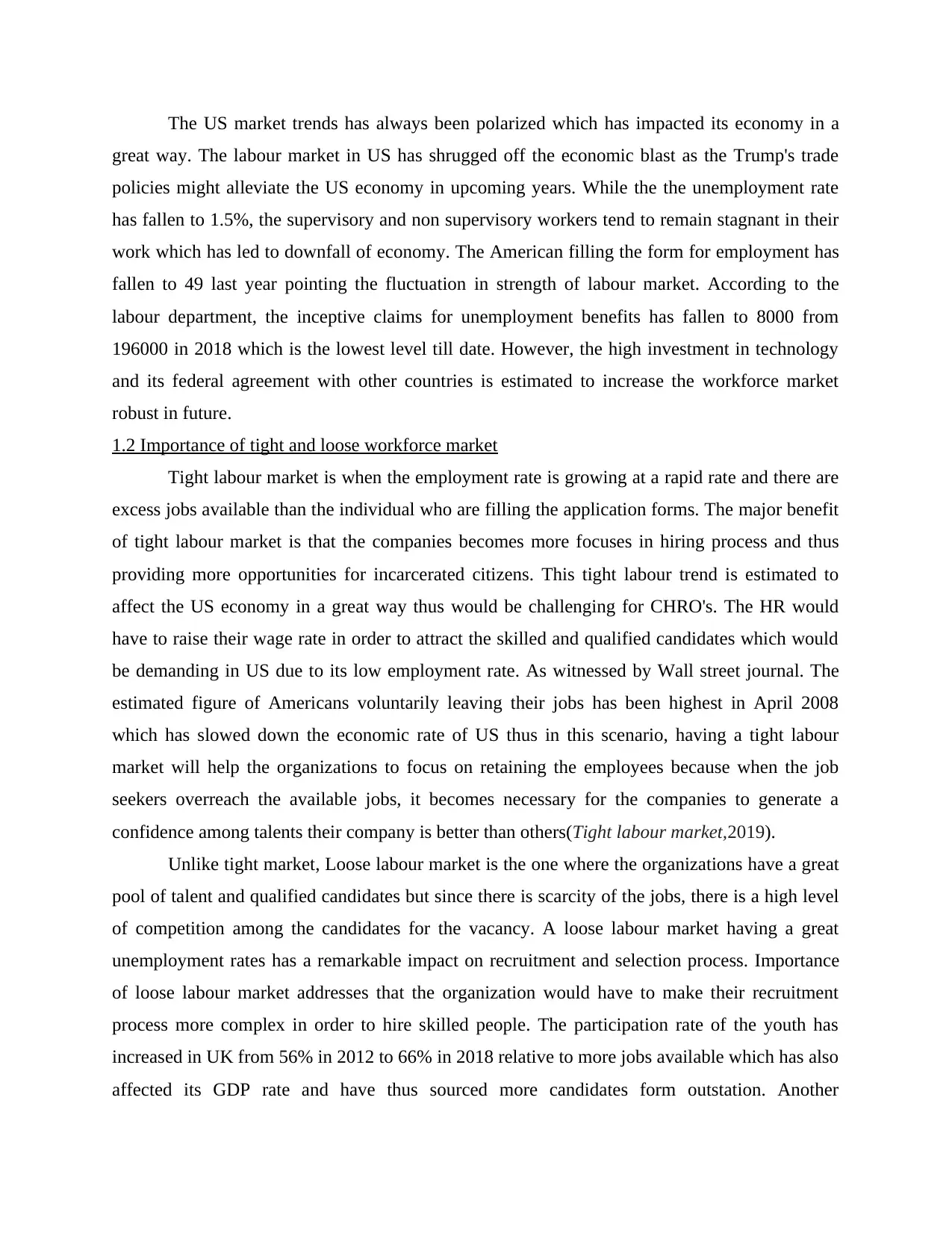
The US market trends has always been polarized which has impacted its economy in a
great way. The labour market in US has shrugged off the economic blast as the Trump's trade
policies might alleviate the US economy in upcoming years. While the the unemployment rate
has fallen to 1.5%, the supervisory and non supervisory workers tend to remain stagnant in their
work which has led to downfall of economy. The American filling the form for employment has
fallen to 49 last year pointing the fluctuation in strength of labour market. According to the
labour department, the inceptive claims for unemployment benefits has fallen to 8000 from
196000 in 2018 which is the lowest level till date. However, the high investment in technology
and its federal agreement with other countries is estimated to increase the workforce market
robust in future.
1.2 Importance of tight and loose workforce market
Tight labour market is when the employment rate is growing at a rapid rate and there are
excess jobs available than the individual who are filling the application forms. The major benefit
of tight labour market is that the companies becomes more focuses in hiring process and thus
providing more opportunities for incarcerated citizens. This tight labour trend is estimated to
affect the US economy in a great way thus would be challenging for CHRO's. The HR would
have to raise their wage rate in order to attract the skilled and qualified candidates which would
be demanding in US due to its low employment rate. As witnessed by Wall street journal. The
estimated figure of Americans voluntarily leaving their jobs has been highest in April 2008
which has slowed down the economic rate of US thus in this scenario, having a tight labour
market will help the organizations to focus on retaining the employees because when the job
seekers overreach the available jobs, it becomes necessary for the companies to generate a
confidence among talents their company is better than others(Tight labour market,2019).
Unlike tight market, Loose labour market is the one where the organizations have a great
pool of talent and qualified candidates but since there is scarcity of the jobs, there is a high level
of competition among the candidates for the vacancy. A loose labour market having a great
unemployment rates has a remarkable impact on recruitment and selection process. Importance
of loose labour market addresses that the organization would have to make their recruitment
process more complex in order to hire skilled people. The participation rate of the youth has
increased in UK from 56% in 2012 to 66% in 2018 relative to more jobs available which has also
affected its GDP rate and have thus sourced more candidates form outstation. Another
great way. The labour market in US has shrugged off the economic blast as the Trump's trade
policies might alleviate the US economy in upcoming years. While the the unemployment rate
has fallen to 1.5%, the supervisory and non supervisory workers tend to remain stagnant in their
work which has led to downfall of economy. The American filling the form for employment has
fallen to 49 last year pointing the fluctuation in strength of labour market. According to the
labour department, the inceptive claims for unemployment benefits has fallen to 8000 from
196000 in 2018 which is the lowest level till date. However, the high investment in technology
and its federal agreement with other countries is estimated to increase the workforce market
robust in future.
1.2 Importance of tight and loose workforce market
Tight labour market is when the employment rate is growing at a rapid rate and there are
excess jobs available than the individual who are filling the application forms. The major benefit
of tight labour market is that the companies becomes more focuses in hiring process and thus
providing more opportunities for incarcerated citizens. This tight labour trend is estimated to
affect the US economy in a great way thus would be challenging for CHRO's. The HR would
have to raise their wage rate in order to attract the skilled and qualified candidates which would
be demanding in US due to its low employment rate. As witnessed by Wall street journal. The
estimated figure of Americans voluntarily leaving their jobs has been highest in April 2008
which has slowed down the economic rate of US thus in this scenario, having a tight labour
market will help the organizations to focus on retaining the employees because when the job
seekers overreach the available jobs, it becomes necessary for the companies to generate a
confidence among talents their company is better than others(Tight labour market,2019).
Unlike tight market, Loose labour market is the one where the organizations have a great
pool of talent and qualified candidates but since there is scarcity of the jobs, there is a high level
of competition among the candidates for the vacancy. A loose labour market having a great
unemployment rates has a remarkable impact on recruitment and selection process. Importance
of loose labour market addresses that the organization would have to make their recruitment
process more complex in order to hire skilled people. The participation rate of the youth has
increased in UK from 56% in 2012 to 66% in 2018 relative to more jobs available which has also
affected its GDP rate and have thus sourced more candidates form outstation. Another
Paraphrase This Document
Need a fresh take? Get an instant paraphrase of this document with our AI Paraphraser
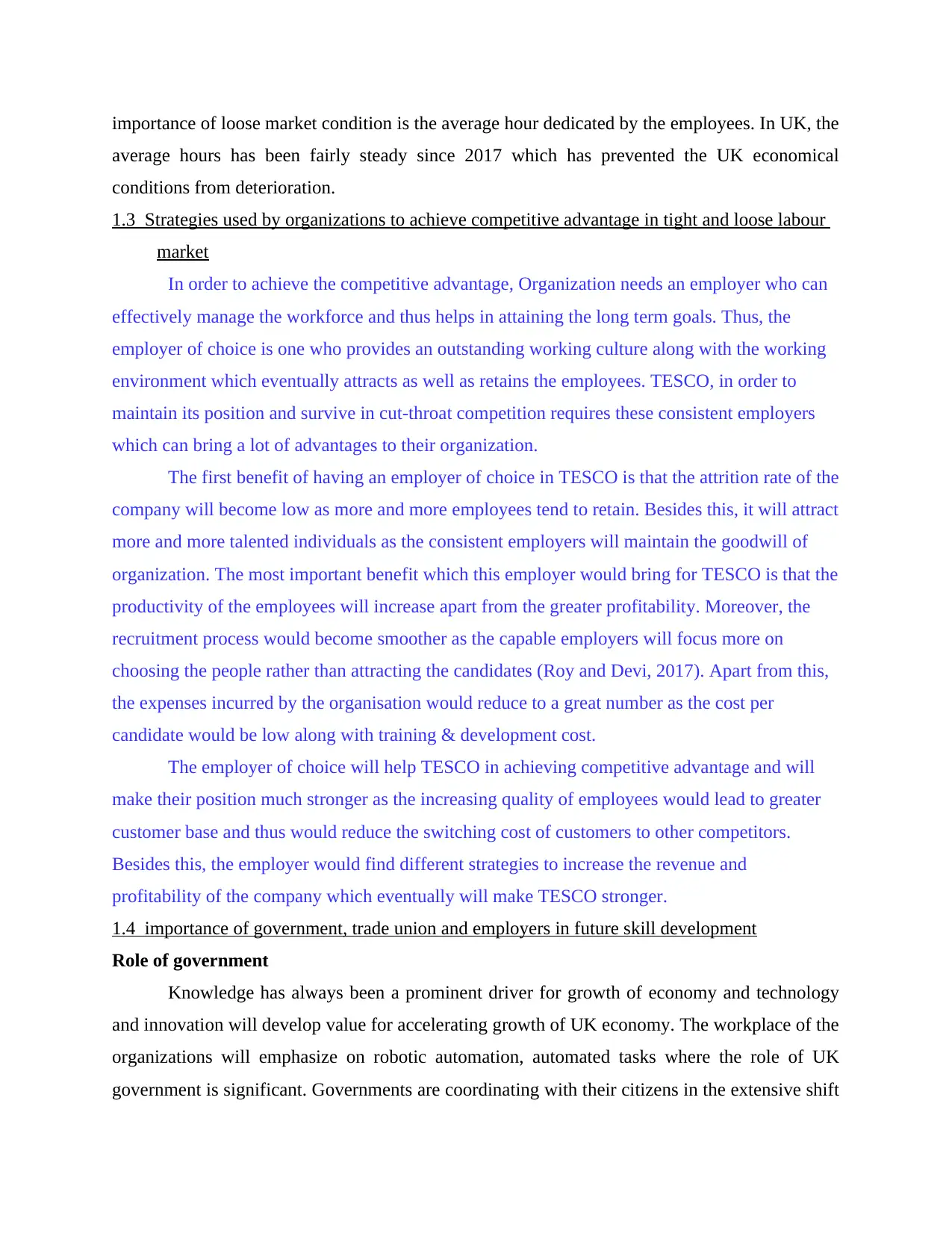
importance of loose market condition is the average hour dedicated by the employees. In UK, the
average hours has been fairly steady since 2017 which has prevented the UK economical
conditions from deterioration.
1.3 Strategies used by organizations to achieve competitive advantage in tight and loose labour
market
In order to achieve the competitive advantage, Organization needs an employer who can
effectively manage the workforce and thus helps in attaining the long term goals. Thus, the
employer of choice is one who provides an outstanding working culture along with the working
environment which eventually attracts as well as retains the employees. TESCO, in order to
maintain its position and survive in cut-throat competition requires these consistent employers
which can bring a lot of advantages to their organization.
The first benefit of having an employer of choice in TESCO is that the attrition rate of the
company will become low as more and more employees tend to retain. Besides this, it will attract
more and more talented individuals as the consistent employers will maintain the goodwill of
organization. The most important benefit which this employer would bring for TESCO is that the
productivity of the employees will increase apart from the greater profitability. Moreover, the
recruitment process would become smoother as the capable employers will focus more on
choosing the people rather than attracting the candidates (Roy and Devi, 2017). Apart from this,
the expenses incurred by the organisation would reduce to a great number as the cost per
candidate would be low along with training & development cost.
The employer of choice will help TESCO in achieving competitive advantage and will
make their position much stronger as the increasing quality of employees would lead to greater
customer base and thus would reduce the switching cost of customers to other competitors.
Besides this, the employer would find different strategies to increase the revenue and
profitability of the company which eventually will make TESCO stronger.
1.4 importance of government, trade union and employers in future skill development
Role of government
Knowledge has always been a prominent driver for growth of economy and technology
and innovation will develop value for accelerating growth of UK economy. The workplace of the
organizations will emphasize on robotic automation, automated tasks where the role of UK
government is significant. Governments are coordinating with their citizens in the extensive shift
average hours has been fairly steady since 2017 which has prevented the UK economical
conditions from deterioration.
1.3 Strategies used by organizations to achieve competitive advantage in tight and loose labour
market
In order to achieve the competitive advantage, Organization needs an employer who can
effectively manage the workforce and thus helps in attaining the long term goals. Thus, the
employer of choice is one who provides an outstanding working culture along with the working
environment which eventually attracts as well as retains the employees. TESCO, in order to
maintain its position and survive in cut-throat competition requires these consistent employers
which can bring a lot of advantages to their organization.
The first benefit of having an employer of choice in TESCO is that the attrition rate of the
company will become low as more and more employees tend to retain. Besides this, it will attract
more and more talented individuals as the consistent employers will maintain the goodwill of
organization. The most important benefit which this employer would bring for TESCO is that the
productivity of the employees will increase apart from the greater profitability. Moreover, the
recruitment process would become smoother as the capable employers will focus more on
choosing the people rather than attracting the candidates (Roy and Devi, 2017). Apart from this,
the expenses incurred by the organisation would reduce to a great number as the cost per
candidate would be low along with training & development cost.
The employer of choice will help TESCO in achieving competitive advantage and will
make their position much stronger as the increasing quality of employees would lead to greater
customer base and thus would reduce the switching cost of customers to other competitors.
Besides this, the employer would find different strategies to increase the revenue and
profitability of the company which eventually will make TESCO stronger.
1.4 importance of government, trade union and employers in future skill development
Role of government
Knowledge has always been a prominent driver for growth of economy and technology
and innovation will develop value for accelerating growth of UK economy. The workplace of the
organizations will emphasize on robotic automation, automated tasks where the role of UK
government is significant. Governments are coordinating with their citizens in the extensive shift
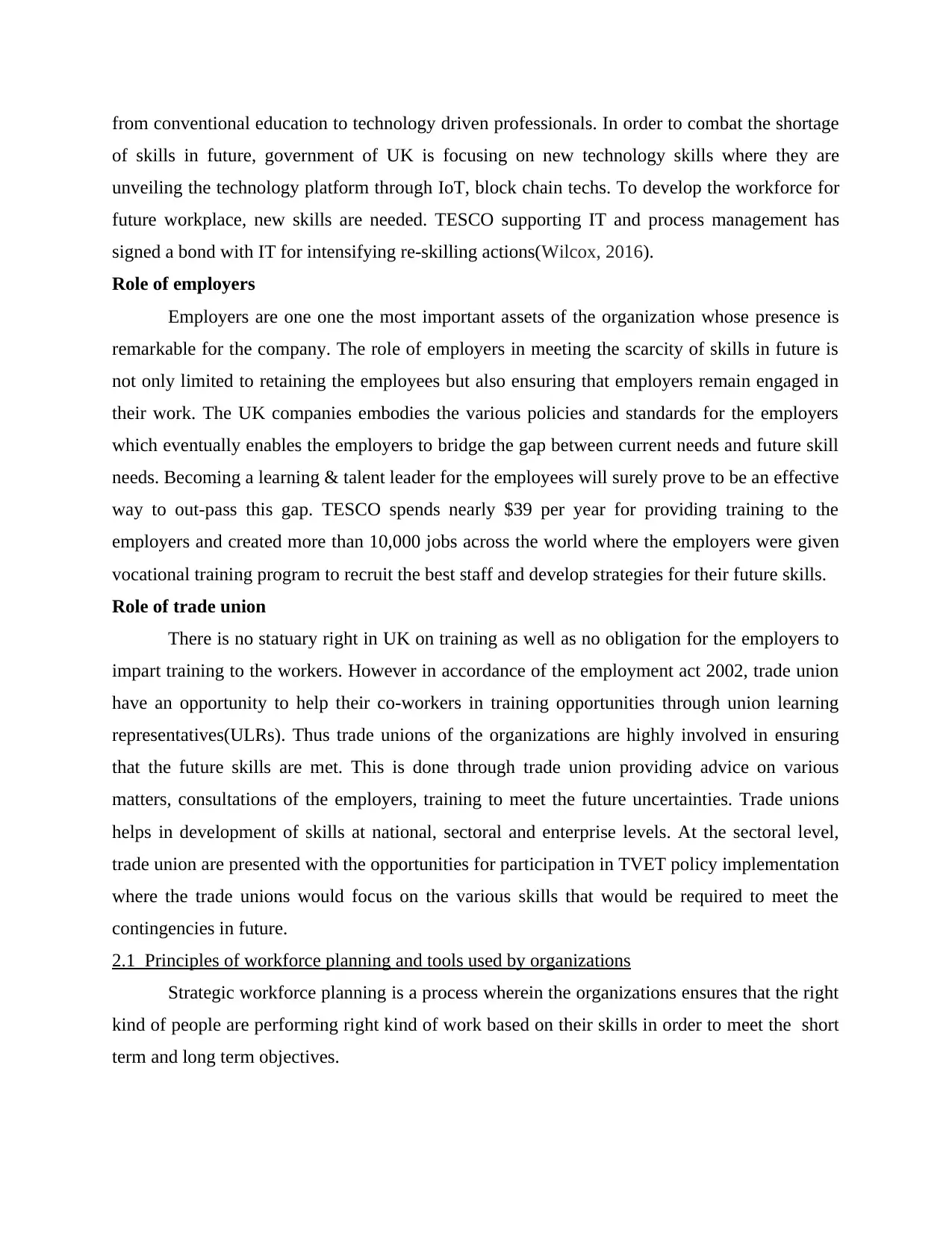
from conventional education to technology driven professionals. In order to combat the shortage
of skills in future, government of UK is focusing on new technology skills where they are
unveiling the technology platform through IoT, block chain techs. To develop the workforce for
future workplace, new skills are needed. TESCO supporting IT and process management has
signed a bond with IT for intensifying re-skilling actions(Wilcox, 2016).
Role of employers
Employers are one one the most important assets of the organization whose presence is
remarkable for the company. The role of employers in meeting the scarcity of skills in future is
not only limited to retaining the employees but also ensuring that employers remain engaged in
their work. The UK companies embodies the various policies and standards for the employers
which eventually enables the employers to bridge the gap between current needs and future skill
needs. Becoming a learning & talent leader for the employees will surely prove to be an effective
way to out-pass this gap. TESCO spends nearly $39 per year for providing training to the
employers and created more than 10,000 jobs across the world where the employers were given
vocational training program to recruit the best staff and develop strategies for their future skills.
Role of trade union
There is no statuary right in UK on training as well as no obligation for the employers to
impart training to the workers. However in accordance of the employment act 2002, trade union
have an opportunity to help their co-workers in training opportunities through union learning
representatives(ULRs). Thus trade unions of the organizations are highly involved in ensuring
that the future skills are met. This is done through trade union providing advice on various
matters, consultations of the employers, training to meet the future uncertainties. Trade unions
helps in development of skills at national, sectoral and enterprise levels. At the sectoral level,
trade union are presented with the opportunities for participation in TVET policy implementation
where the trade unions would focus on the various skills that would be required to meet the
contingencies in future.
2.1 Principles of workforce planning and tools used by organizations
Strategic workforce planning is a process wherein the organizations ensures that the right
kind of people are performing right kind of work based on their skills in order to meet the short
term and long term objectives.
of skills in future, government of UK is focusing on new technology skills where they are
unveiling the technology platform through IoT, block chain techs. To develop the workforce for
future workplace, new skills are needed. TESCO supporting IT and process management has
signed a bond with IT for intensifying re-skilling actions(Wilcox, 2016).
Role of employers
Employers are one one the most important assets of the organization whose presence is
remarkable for the company. The role of employers in meeting the scarcity of skills in future is
not only limited to retaining the employees but also ensuring that employers remain engaged in
their work. The UK companies embodies the various policies and standards for the employers
which eventually enables the employers to bridge the gap between current needs and future skill
needs. Becoming a learning & talent leader for the employees will surely prove to be an effective
way to out-pass this gap. TESCO spends nearly $39 per year for providing training to the
employers and created more than 10,000 jobs across the world where the employers were given
vocational training program to recruit the best staff and develop strategies for their future skills.
Role of trade union
There is no statuary right in UK on training as well as no obligation for the employers to
impart training to the workers. However in accordance of the employment act 2002, trade union
have an opportunity to help their co-workers in training opportunities through union learning
representatives(ULRs). Thus trade unions of the organizations are highly involved in ensuring
that the future skills are met. This is done through trade union providing advice on various
matters, consultations of the employers, training to meet the future uncertainties. Trade unions
helps in development of skills at national, sectoral and enterprise levels. At the sectoral level,
trade union are presented with the opportunities for participation in TVET policy implementation
where the trade unions would focus on the various skills that would be required to meet the
contingencies in future.
2.1 Principles of workforce planning and tools used by organizations
Strategic workforce planning is a process wherein the organizations ensures that the right
kind of people are performing right kind of work based on their skills in order to meet the short
term and long term objectives.
⊘ This is a preview!⊘
Do you want full access?
Subscribe today to unlock all pages.

Trusted by 1+ million students worldwide
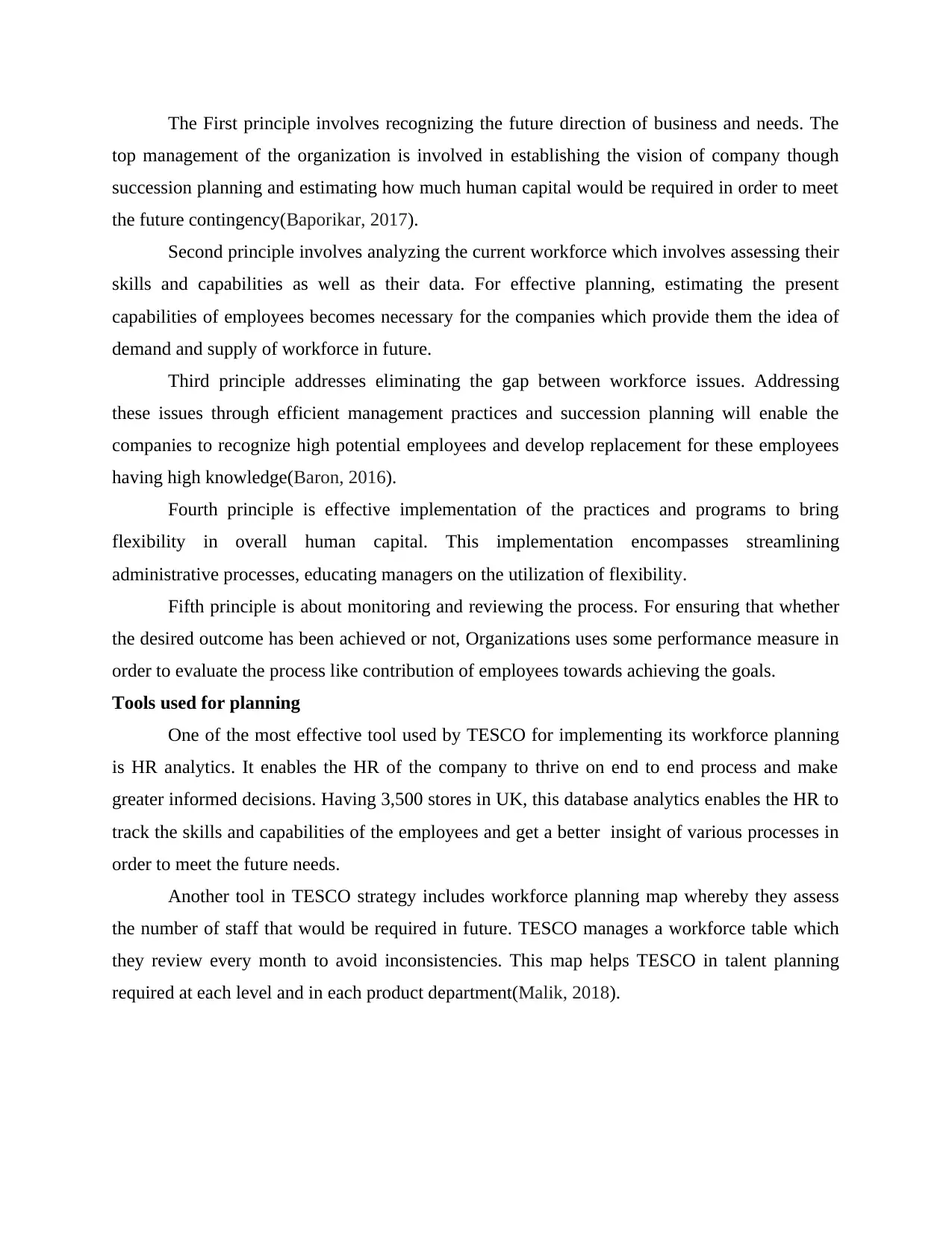
The First principle involves recognizing the future direction of business and needs. The
top management of the organization is involved in establishing the vision of company though
succession planning and estimating how much human capital would be required in order to meet
the future contingency(Baporikar, 2017).
Second principle involves analyzing the current workforce which involves assessing their
skills and capabilities as well as their data. For effective planning, estimating the present
capabilities of employees becomes necessary for the companies which provide them the idea of
demand and supply of workforce in future.
Third principle addresses eliminating the gap between workforce issues. Addressing
these issues through efficient management practices and succession planning will enable the
companies to recognize high potential employees and develop replacement for these employees
having high knowledge(Baron, 2016).
Fourth principle is effective implementation of the practices and programs to bring
flexibility in overall human capital. This implementation encompasses streamlining
administrative processes, educating managers on the utilization of flexibility.
Fifth principle is about monitoring and reviewing the process. For ensuring that whether
the desired outcome has been achieved or not, Organizations uses some performance measure in
order to evaluate the process like contribution of employees towards achieving the goals.
Tools used for planning
One of the most effective tool used by TESCO for implementing its workforce planning
is HR analytics. It enables the HR of the company to thrive on end to end process and make
greater informed decisions. Having 3,500 stores in UK, this database analytics enables the HR to
track the skills and capabilities of the employees and get a better insight of various processes in
order to meet the future needs.
Another tool in TESCO strategy includes workforce planning map whereby they assess
the number of staff that would be required in future. TESCO manages a workforce table which
they review every month to avoid inconsistencies. This map helps TESCO in talent planning
required at each level and in each product department(Malik, 2018).
top management of the organization is involved in establishing the vision of company though
succession planning and estimating how much human capital would be required in order to meet
the future contingency(Baporikar, 2017).
Second principle involves analyzing the current workforce which involves assessing their
skills and capabilities as well as their data. For effective planning, estimating the present
capabilities of employees becomes necessary for the companies which provide them the idea of
demand and supply of workforce in future.
Third principle addresses eliminating the gap between workforce issues. Addressing
these issues through efficient management practices and succession planning will enable the
companies to recognize high potential employees and develop replacement for these employees
having high knowledge(Baron, 2016).
Fourth principle is effective implementation of the practices and programs to bring
flexibility in overall human capital. This implementation encompasses streamlining
administrative processes, educating managers on the utilization of flexibility.
Fifth principle is about monitoring and reviewing the process. For ensuring that whether
the desired outcome has been achieved or not, Organizations uses some performance measure in
order to evaluate the process like contribution of employees towards achieving the goals.
Tools used for planning
One of the most effective tool used by TESCO for implementing its workforce planning
is HR analytics. It enables the HR of the company to thrive on end to end process and make
greater informed decisions. Having 3,500 stores in UK, this database analytics enables the HR to
track the skills and capabilities of the employees and get a better insight of various processes in
order to meet the future needs.
Another tool in TESCO strategy includes workforce planning map whereby they assess
the number of staff that would be required in future. TESCO manages a workforce table which
they review every month to avoid inconsistencies. This map helps TESCO in talent planning
required at each level and in each product department(Malik, 2018).
Paraphrase This Document
Need a fresh take? Get an instant paraphrase of this document with our AI Paraphraser
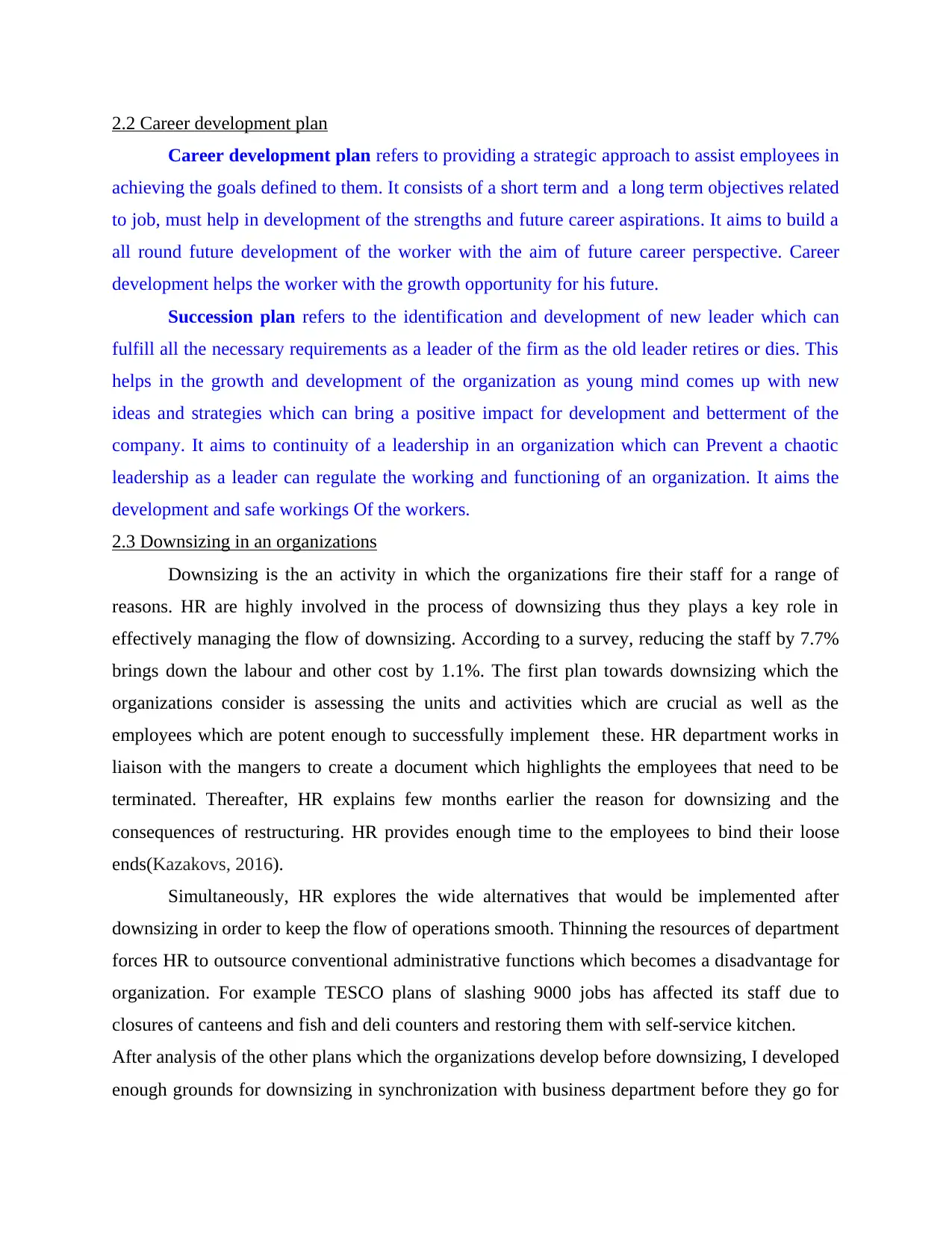
2.2 Career development plan
Career development plan refers to providing a strategic approach to assist employees in
achieving the goals defined to them. It consists of a short term and a long term objectives related
to job, must help in development of the strengths and future career aspirations. It aims to build a
all round future development of the worker with the aim of future career perspective. Career
development helps the worker with the growth opportunity for his future.
Succession plan refers to the identification and development of new leader which can
fulfill all the necessary requirements as a leader of the firm as the old leader retires or dies. This
helps in the growth and development of the organization as young mind comes up with new
ideas and strategies which can bring a positive impact for development and betterment of the
company. It aims to continuity of a leadership in an organization which can Prevent a chaotic
leadership as a leader can regulate the working and functioning of an organization. It aims the
development and safe workings Of the workers.
2.3 Downsizing in an organizations
Downsizing is the an activity in which the organizations fire their staff for a range of
reasons. HR are highly involved in the process of downsizing thus they plays a key role in
effectively managing the flow of downsizing. According to a survey, reducing the staff by 7.7%
brings down the labour and other cost by 1.1%. The first plan towards downsizing which the
organizations consider is assessing the units and activities which are crucial as well as the
employees which are potent enough to successfully implement these. HR department works in
liaison with the mangers to create a document which highlights the employees that need to be
terminated. Thereafter, HR explains few months earlier the reason for downsizing and the
consequences of restructuring. HR provides enough time to the employees to bind their loose
ends(Kazakovs, 2016).
Simultaneously, HR explores the wide alternatives that would be implemented after
downsizing in order to keep the flow of operations smooth. Thinning the resources of department
forces HR to outsource conventional administrative functions which becomes a disadvantage for
organization. For example TESCO plans of slashing 9000 jobs has affected its staff due to
closures of canteens and fish and deli counters and restoring them with self-service kitchen.
After analysis of the other plans which the organizations develop before downsizing, I developed
enough grounds for downsizing in synchronization with business department before they go for
Career development plan refers to providing a strategic approach to assist employees in
achieving the goals defined to them. It consists of a short term and a long term objectives related
to job, must help in development of the strengths and future career aspirations. It aims to build a
all round future development of the worker with the aim of future career perspective. Career
development helps the worker with the growth opportunity for his future.
Succession plan refers to the identification and development of new leader which can
fulfill all the necessary requirements as a leader of the firm as the old leader retires or dies. This
helps in the growth and development of the organization as young mind comes up with new
ideas and strategies which can bring a positive impact for development and betterment of the
company. It aims to continuity of a leadership in an organization which can Prevent a chaotic
leadership as a leader can regulate the working and functioning of an organization. It aims the
development and safe workings Of the workers.
2.3 Downsizing in an organizations
Downsizing is the an activity in which the organizations fire their staff for a range of
reasons. HR are highly involved in the process of downsizing thus they plays a key role in
effectively managing the flow of downsizing. According to a survey, reducing the staff by 7.7%
brings down the labour and other cost by 1.1%. The first plan towards downsizing which the
organizations consider is assessing the units and activities which are crucial as well as the
employees which are potent enough to successfully implement these. HR department works in
liaison with the mangers to create a document which highlights the employees that need to be
terminated. Thereafter, HR explains few months earlier the reason for downsizing and the
consequences of restructuring. HR provides enough time to the employees to bind their loose
ends(Kazakovs, 2016).
Simultaneously, HR explores the wide alternatives that would be implemented after
downsizing in order to keep the flow of operations smooth. Thinning the resources of department
forces HR to outsource conventional administrative functions which becomes a disadvantage for
organization. For example TESCO plans of slashing 9000 jobs has affected its staff due to
closures of canteens and fish and deli counters and restoring them with self-service kitchen.
After analysis of the other plans which the organizations develop before downsizing, I developed
enough grounds for downsizing in synchronization with business department before they go for
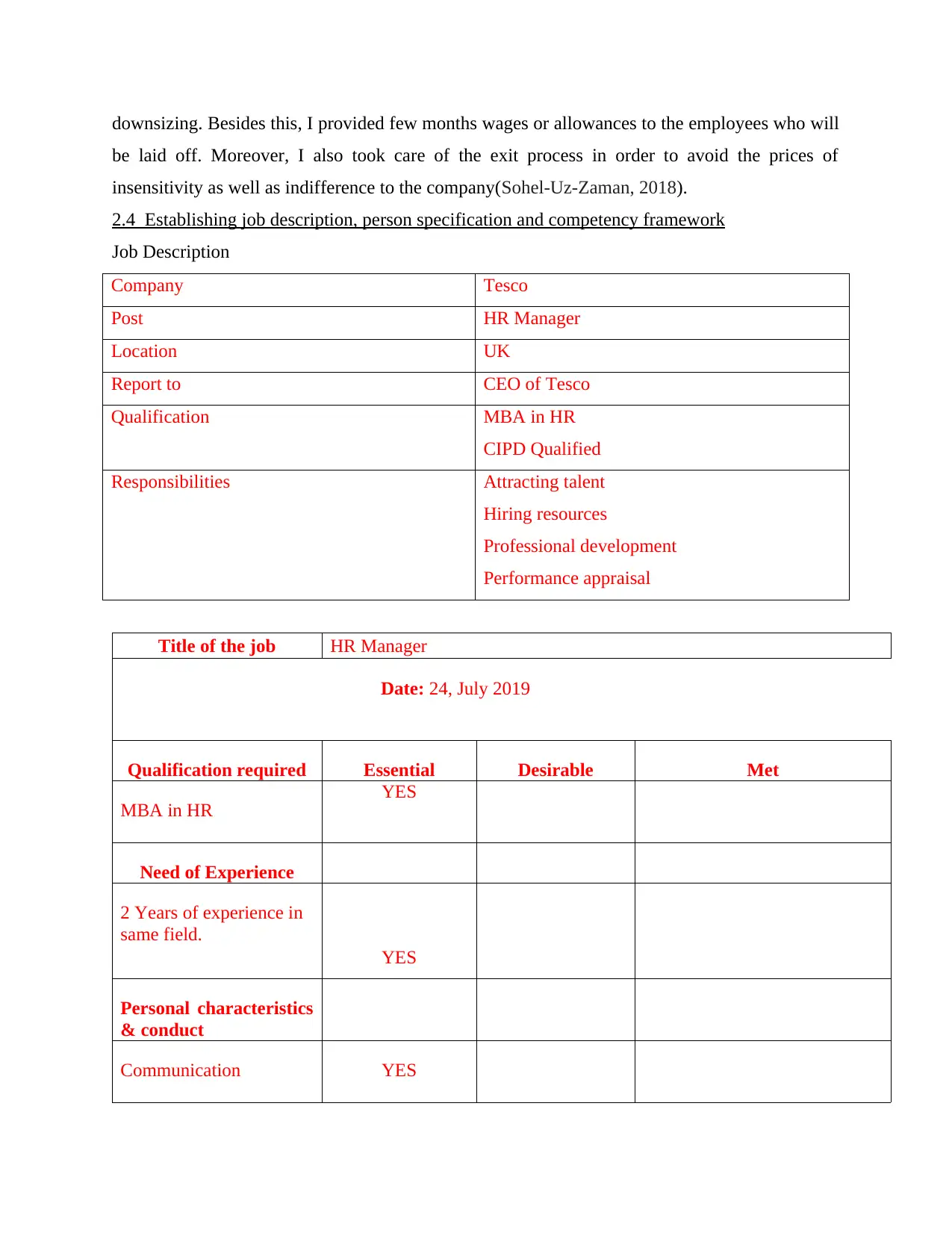
downsizing. Besides this, I provided few months wages or allowances to the employees who will
be laid off. Moreover, I also took care of the exit process in order to avoid the prices of
insensitivity as well as indifference to the company(Sohel-Uz-Zaman, 2018).
2.4 Establishing job description, person specification and competency framework
Job Description
Company Tesco
Post HR Manager
Location UK
Report to CEO of Tesco
Qualification MBA in HR
CIPD Qualified
Responsibilities Attracting talent
Hiring resources
Professional development
Performance appraisal
Title of the job HR Manager
Date: 24, July 2019
Qualification required Essential Desirable Met
MBA in HR YES
Need of Experience
2 Years of experience in
same field.
YES
Personal characteristics
& conduct
Communication YES
be laid off. Moreover, I also took care of the exit process in order to avoid the prices of
insensitivity as well as indifference to the company(Sohel-Uz-Zaman, 2018).
2.4 Establishing job description, person specification and competency framework
Job Description
Company Tesco
Post HR Manager
Location UK
Report to CEO of Tesco
Qualification MBA in HR
CIPD Qualified
Responsibilities Attracting talent
Hiring resources
Professional development
Performance appraisal
Title of the job HR Manager
Date: 24, July 2019
Qualification required Essential Desirable Met
MBA in HR YES
Need of Experience
2 Years of experience in
same field.
YES
Personal characteristics
& conduct
Communication YES
⊘ This is a preview!⊘
Do you want full access?
Subscribe today to unlock all pages.

Trusted by 1+ million students worldwide
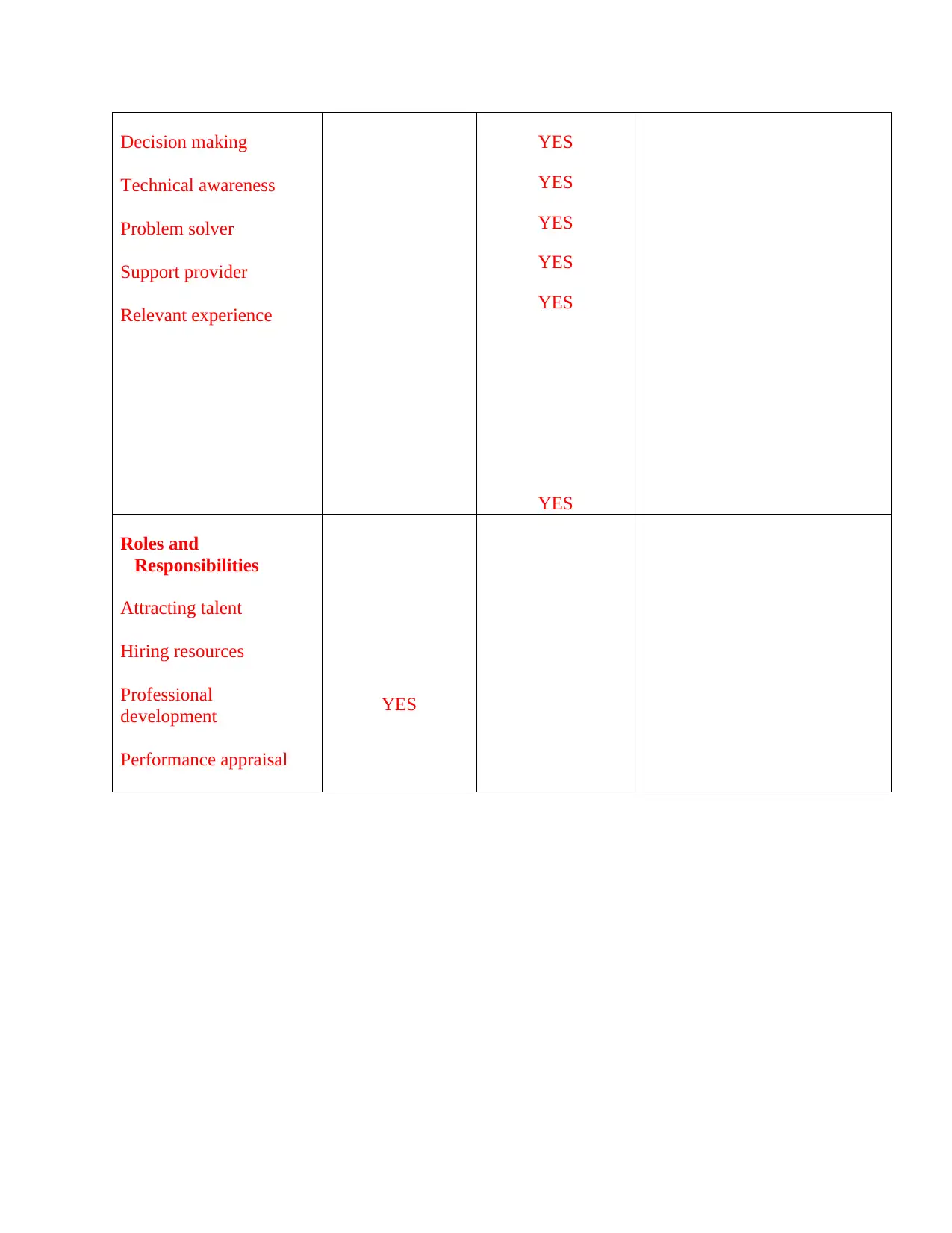
Decision making
Technical awareness
Problem solver
Support provider
Relevant experience
YES
YES
YES
YES
YES
YES
Roles and
Responsibilities
Attracting talent
Hiring resources
Professional
development
Performance appraisal
YES
Technical awareness
Problem solver
Support provider
Relevant experience
YES
YES
YES
YES
YES
YES
Roles and
Responsibilities
Attracting talent
Hiring resources
Professional
development
Performance appraisal
YES
Paraphrase This Document
Need a fresh take? Get an instant paraphrase of this document with our AI Paraphraser
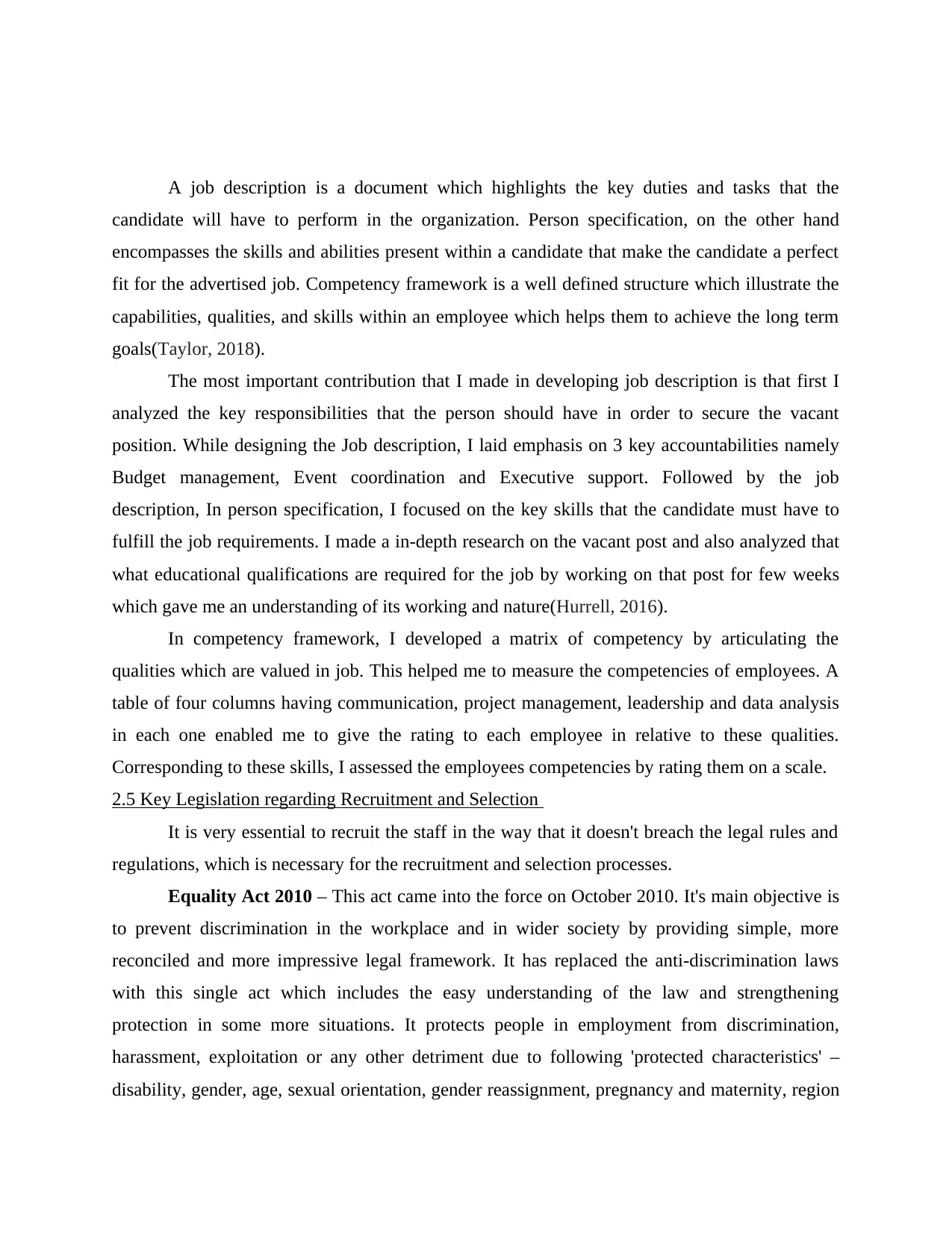
A job description is a document which highlights the key duties and tasks that the
candidate will have to perform in the organization. Person specification, on the other hand
encompasses the skills and abilities present within a candidate that make the candidate a perfect
fit for the advertised job. Competency framework is a well defined structure which illustrate the
capabilities, qualities, and skills within an employee which helps them to achieve the long term
goals(Taylor, 2018).
The most important contribution that I made in developing job description is that first I
analyzed the key responsibilities that the person should have in order to secure the vacant
position. While designing the Job description, I laid emphasis on 3 key accountabilities namely
Budget management, Event coordination and Executive support. Followed by the job
description, In person specification, I focused on the key skills that the candidate must have to
fulfill the job requirements. I made a in-depth research on the vacant post and also analyzed that
what educational qualifications are required for the job by working on that post for few weeks
which gave me an understanding of its working and nature(Hurrell, 2016).
In competency framework, I developed a matrix of competency by articulating the
qualities which are valued in job. This helped me to measure the competencies of employees. A
table of four columns having communication, project management, leadership and data analysis
in each one enabled me to give the rating to each employee in relative to these qualities.
Corresponding to these skills, I assessed the employees competencies by rating them on a scale.
2.5 Key Legislation regarding Recruitment and Selection
It is very essential to recruit the staff in the way that it doesn't breach the legal rules and
regulations, which is necessary for the recruitment and selection processes.
Equality Act 2010 – This act came into the force on October 2010. It's main objective is
to prevent discrimination in the workplace and in wider society by providing simple, more
reconciled and more impressive legal framework. It has replaced the anti-discrimination laws
with this single act which includes the easy understanding of the law and strengthening
protection in some more situations. It protects people in employment from discrimination,
harassment, exploitation or any other detriment due to following 'protected characteristics' –
disability, gender, age, sexual orientation, gender reassignment, pregnancy and maternity, region
candidate will have to perform in the organization. Person specification, on the other hand
encompasses the skills and abilities present within a candidate that make the candidate a perfect
fit for the advertised job. Competency framework is a well defined structure which illustrate the
capabilities, qualities, and skills within an employee which helps them to achieve the long term
goals(Taylor, 2018).
The most important contribution that I made in developing job description is that first I
analyzed the key responsibilities that the person should have in order to secure the vacant
position. While designing the Job description, I laid emphasis on 3 key accountabilities namely
Budget management, Event coordination and Executive support. Followed by the job
description, In person specification, I focused on the key skills that the candidate must have to
fulfill the job requirements. I made a in-depth research on the vacant post and also analyzed that
what educational qualifications are required for the job by working on that post for few weeks
which gave me an understanding of its working and nature(Hurrell, 2016).
In competency framework, I developed a matrix of competency by articulating the
qualities which are valued in job. This helped me to measure the competencies of employees. A
table of four columns having communication, project management, leadership and data analysis
in each one enabled me to give the rating to each employee in relative to these qualities.
Corresponding to these skills, I assessed the employees competencies by rating them on a scale.
2.5 Key Legislation regarding Recruitment and Selection
It is very essential to recruit the staff in the way that it doesn't breach the legal rules and
regulations, which is necessary for the recruitment and selection processes.
Equality Act 2010 – This act came into the force on October 2010. It's main objective is
to prevent discrimination in the workplace and in wider society by providing simple, more
reconciled and more impressive legal framework. It has replaced the anti-discrimination laws
with this single act which includes the easy understanding of the law and strengthening
protection in some more situations. It protects people in employment from discrimination,
harassment, exploitation or any other detriment due to following 'protected characteristics' –
disability, gender, age, sexual orientation, gender reassignment, pregnancy and maternity, region
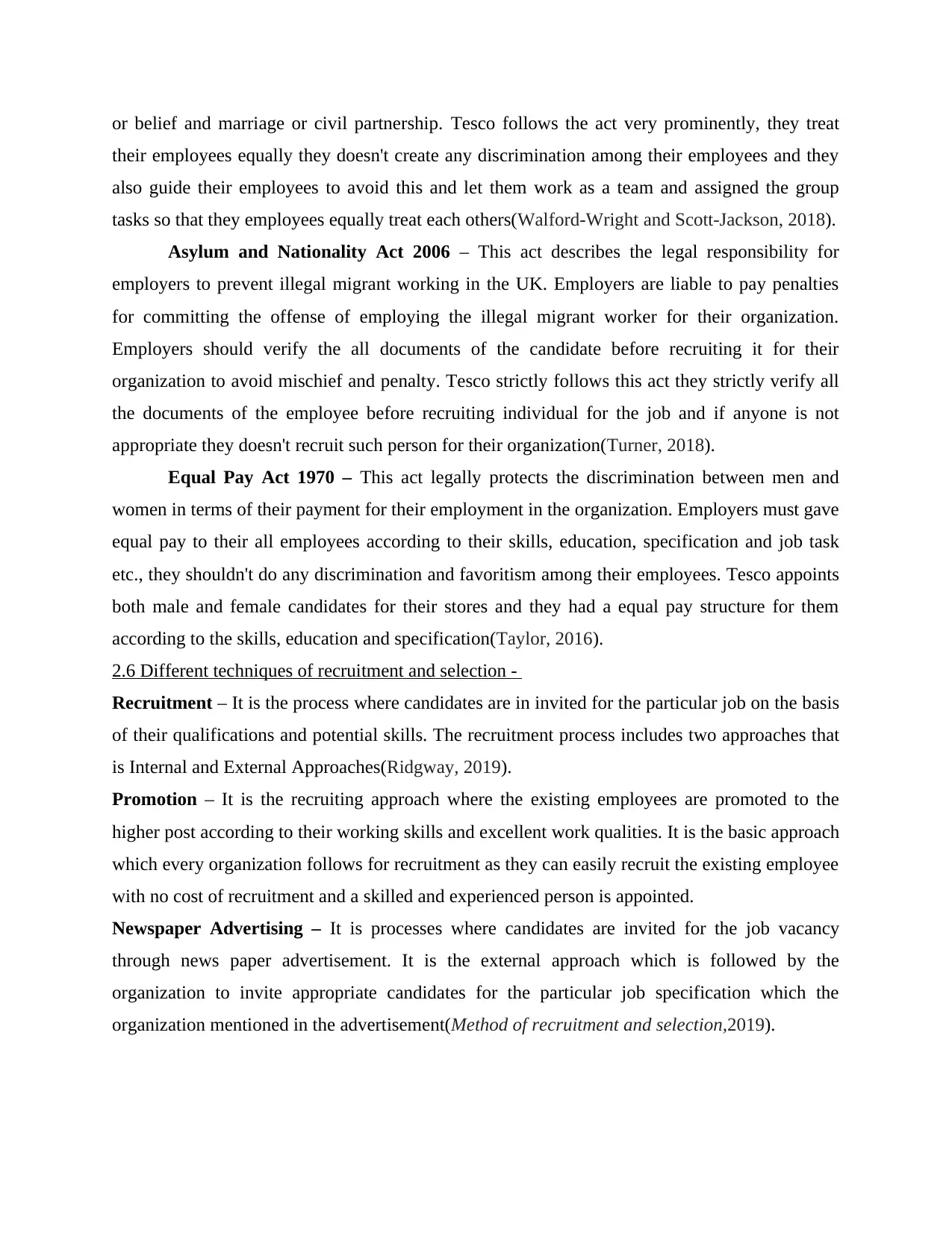
or belief and marriage or civil partnership. Tesco follows the act very prominently, they treat
their employees equally they doesn't create any discrimination among their employees and they
also guide their employees to avoid this and let them work as a team and assigned the group
tasks so that they employees equally treat each others(Walford-Wright and Scott-Jackson, 2018).
Asylum and Nationality Act 2006 – This act describes the legal responsibility for
employers to prevent illegal migrant working in the UK. Employers are liable to pay penalties
for committing the offense of employing the illegal migrant worker for their organization.
Employers should verify the all documents of the candidate before recruiting it for their
organization to avoid mischief and penalty. Tesco strictly follows this act they strictly verify all
the documents of the employee before recruiting individual for the job and if anyone is not
appropriate they doesn't recruit such person for their organization(Turner, 2018).
Equal Pay Act 1970 – This act legally protects the discrimination between men and
women in terms of their payment for their employment in the organization. Employers must gave
equal pay to their all employees according to their skills, education, specification and job task
etc., they shouldn't do any discrimination and favoritism among their employees. Tesco appoints
both male and female candidates for their stores and they had a equal pay structure for them
according to the skills, education and specification(Taylor, 2016).
2.6 Different techniques of recruitment and selection -
Recruitment – It is the process where candidates are in invited for the particular job on the basis
of their qualifications and potential skills. The recruitment process includes two approaches that
is Internal and External Approaches(Ridgway, 2019).
Promotion – It is the recruiting approach where the existing employees are promoted to the
higher post according to their working skills and excellent work qualities. It is the basic approach
which every organization follows for recruitment as they can easily recruit the existing employee
with no cost of recruitment and a skilled and experienced person is appointed.
Newspaper Advertising – It is processes where candidates are invited for the job vacancy
through news paper advertisement. It is the external approach which is followed by the
organization to invite appropriate candidates for the particular job specification which the
organization mentioned in the advertisement(Method of recruitment and selection,2019).
their employees equally they doesn't create any discrimination among their employees and they
also guide their employees to avoid this and let them work as a team and assigned the group
tasks so that they employees equally treat each others(Walford-Wright and Scott-Jackson, 2018).
Asylum and Nationality Act 2006 – This act describes the legal responsibility for
employers to prevent illegal migrant working in the UK. Employers are liable to pay penalties
for committing the offense of employing the illegal migrant worker for their organization.
Employers should verify the all documents of the candidate before recruiting it for their
organization to avoid mischief and penalty. Tesco strictly follows this act they strictly verify all
the documents of the employee before recruiting individual for the job and if anyone is not
appropriate they doesn't recruit such person for their organization(Turner, 2018).
Equal Pay Act 1970 – This act legally protects the discrimination between men and
women in terms of their payment for their employment in the organization. Employers must gave
equal pay to their all employees according to their skills, education, specification and job task
etc., they shouldn't do any discrimination and favoritism among their employees. Tesco appoints
both male and female candidates for their stores and they had a equal pay structure for them
according to the skills, education and specification(Taylor, 2016).
2.6 Different techniques of recruitment and selection -
Recruitment – It is the process where candidates are in invited for the particular job on the basis
of their qualifications and potential skills. The recruitment process includes two approaches that
is Internal and External Approaches(Ridgway, 2019).
Promotion – It is the recruiting approach where the existing employees are promoted to the
higher post according to their working skills and excellent work qualities. It is the basic approach
which every organization follows for recruitment as they can easily recruit the existing employee
with no cost of recruitment and a skilled and experienced person is appointed.
Newspaper Advertising – It is processes where candidates are invited for the job vacancy
through news paper advertisement. It is the external approach which is followed by the
organization to invite appropriate candidates for the particular job specification which the
organization mentioned in the advertisement(Method of recruitment and selection,2019).
⊘ This is a preview!⊘
Do you want full access?
Subscribe today to unlock all pages.

Trusted by 1+ million students worldwide
1 out of 22
Related Documents
Your All-in-One AI-Powered Toolkit for Academic Success.
+13062052269
info@desklib.com
Available 24*7 on WhatsApp / Email
![[object Object]](/_next/static/media/star-bottom.7253800d.svg)
Unlock your academic potential
Copyright © 2020–2025 A2Z Services. All Rights Reserved. Developed and managed by ZUCOL.





